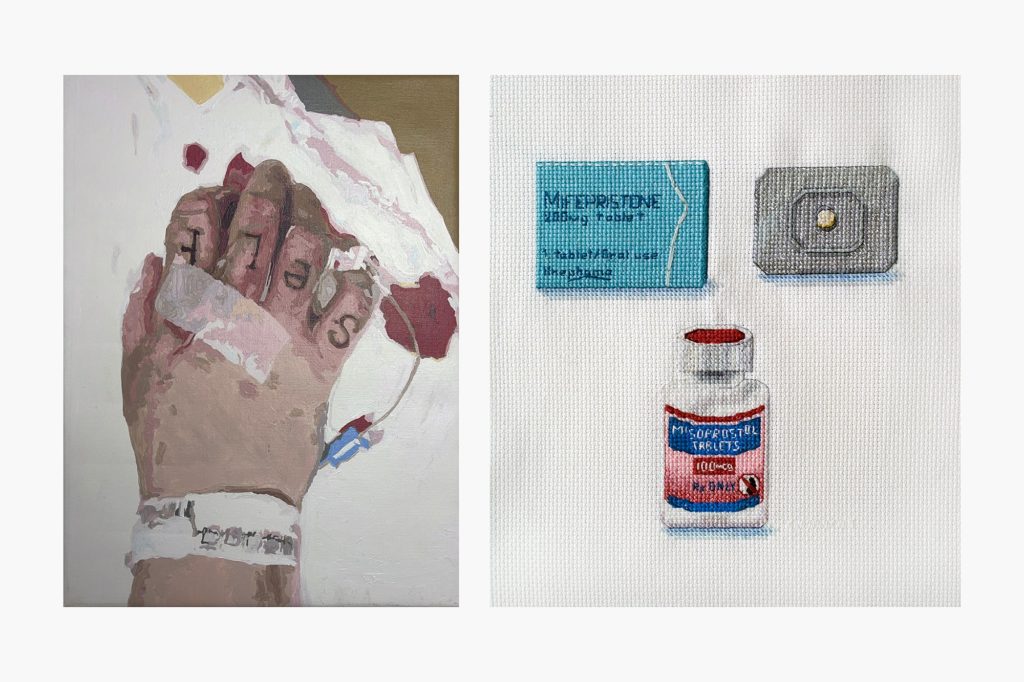
Unconditional Care explores today’s most pressing health issues and shares the stories and concerns of those most directly impacted by them. From chronic illnesses, pregnancy, cancer, and gun deaths to sexual assault, the artists share their powerful personal experiences. Through video, sculpture, painting, and photography, they reveal how complicated it is to navigate their mental and physical health within America’s healthcare, legislative, and social systems. Taking a holistic approach to understanding and improving access to bodily autonomy and health, the exhibition also examines where improvements in representation can be made within the care economy, sex education, and the medical field. In a time where health is politicized and controlled through bias, power, and misinformation, the exhibition prescribes treating a person and their health needs with open-minded listening and empathy—the radical idea of giving someone unconditional care.
Artist Lydia Nobles acutely frames this historical need for unconditional care through personal storytelling with her series As I Sit Waiting. Often missing from the conversation and decision-making around healthcare legislation are direct stories from those most affected. Nobles’ videos feature three women’s pregnancy stories and the personal decisions they made to protect their health and that of their family’s. Her interviews bring attention to the necessity of personal choice and how women’s health needs are at odds with the precarious state of abortion and reproductive healthcare in a post-Roe America. As I Sit Waiting gives a platform to women’s voices that have been either silenced or ignored when deciding on U.S. state abortion policies.
The human cost of America’s post-Roe conditions and reproductive war on women is encapsulated in Michelle Hartney’s Mother’s Right. Hartney, alongside doulas and midwives, sewed a hospital gown for every American woman who died from pregnancy-related causes in 2013. The 41 gowns on exhibit represent maternal deaths of New York women in 2018, which has been gradually increasing since then. Mother’s Right brings attention to how, out of all developed nations, America has one of the highest maternal death rates—and the rate continues to increase. The project particularly notes how maternal deaths for Black American women are nearly three times higher than white women.[1]
Niger-based medical illustrator Chidiebere Ibe wants to change that statistic through social awareness and spreading medically accurate information. In 2021, he created the first-ever medical illustration of a Black fetus and mother. The radicalism of this simple gesture went viral worldwide. By believing change begins with better representation, Ibe’s artwork calls attention not just to the disparities in healthcare among races, but also the care received from the medical industries and professionals who have taken an oath to protect the lives of their patients. His works imagine what inclusive medicine can be.
Further exploring this idea of Black bodies within medical spaces, jessica susan oler’s art investigates her treatment as a Black American, a woman, and someone with a chronic illness. Through photography, The Weight exposes the emotional trauma of those experiences defined by what she calls Black Geographies and the effect of "unprotected Black female flesh." But in her intimate sharing, she is also taking control of her narrative and finding strength, something she encourages others to do while shaping their personal patient narrative. Her artwork and social practice drive the idea to “treat the person, not the patient.”
Kean O’Brien similarly searches for respect in medical institutions that still operate with colonial-biases, and cis, heteronormativity, and traditional gender roles. By inviting the viewers into paintings of O’Brien’s hospital stays, he is bringing attention to the environments in which he can freely and comfortably enter as a chronically ill, disabled white person, yet that identity and privilege is at odds with the treatment he often receives as a queer trans person. Like the other artists, O’Brien asks how he and others can receive the care they need with full human dignity and kindness.
The digital prints of Christen Clifford’s Instagram posts bear intimate witness to her personal journey with breast cancer. Clifford’s poetic diary-like posts grapple with how her life saving surgeries challenge her very notions of womanhood, sexuality, body positivity, motherhood, and gender identity. Despite one in eight U.S. women contracting breast cancer, the surgical procedures and changes to the body are often hidden from public view. Clifford brings the nature and physicality of her DIEP Flap and double mastectomy surgery to the forefront of public understanding - making her posts as much a place of education and activism as a place for her to come to terms with her health decisions and her body.
The CareForce One Travelogues of Marisa Morán Jahn examine a different angle of living with care and comfort, particularly via the services provided by those within the care economy. The care economy is defined as paid help to assist in maintaining the welfare of children, elders, the infirm, and others in need. Jahn brings attention to how American work policies inadequately extend to caregivers, which can adversely affect their personal health and ability to do their job well. The videos highlight how a lack of protections and fair wages are tied to slavery, anti-immigration, and sexism. By calling for a healthier employment system, the videos theorize that everyone will benefit, especially as America faces an increasingly aging and longer-lived population who will need more help to live day-to-day.
This idea of health as a business and commodity is reiterated in the sculptures and x-ray photography of local Rochester artist, Holland Houdek. Houdek’s medical implants bring attention to how medical devices are connected to privilege, wealth, and sociopolitical issues. When a person’s quality and longevity of life hangs in the balance based on access to these products, it contextualizes America’s current debate surrounding free healthcare and questions the existing healthcare system that controls people’s path to health and thus happiness.
Artist Martha Poggioli explores the intersection of medical technology, medical need, and business in her series An Incomplete Patent Chronology. The exhibiting artwork highlights the various family planning medical devices that have been designed over the course of modern medicine. The breadth of products show the numerous attempts for medical science to meet the physical and need-based demands of reproductive bodies (and profit off those them), despite birth control being under threat in the U.S. With sex education disappearing in the U.S., the artwork acts as a sort of informal health education too.
The protection of families and young lives is arguably a common concern among all Americans regardless of political affiliations. Where many differ is in the definition and means of protection, especially when it comes to the second amendment. While the activist group Gays Against Guns (GAG) takes a strong stance in their name alone, one of the group’s primary objective is to honor and remember the lives tragically lost to gun violence, an endemic health issue in America. Though the group often responds to mass shooting events, for this exhibit, GAG was asked to focus on how gun violence has affected the local community. In 2022, Rochester had the 4th highest rate of homicides in the U.S. with firearms as the most common cause of death. In thinking about those often not represented in the epidemic of gun violence, GAG decided to focus on women. Statistically, women are five times more likely to be killed by an abusive partner who has access to a gun.[3] The 10 placards honor a selection of local women (based on available public information) lost to gun violence and intimate partner violence. They are remembered so that their lives are not lost in vain.
Domestic violence is a strong theme in the exhibit. Health is often perceived as the physical functioning of the body, yet health extends to bodily autonomy and the ability to live in mental and physical safety. The art by Nimíipuu artist Helen Goodteacher addresses concerns of gender-based violence (femicide) by bringing awareness to the ongoing crisis of missing and murdered indigenous women (MMIW).[4] Indigenous women are disproportionately targets of violence by non-native/non-indigenous perpetrators due to racist and sexist othering and because there are few protections for survivors and few repercussions for such crimes. In America, 80% of indigenous women have been victimized by violence. Crimes are seldom reported, investigated, or prosecuted. This is a result of poor resources, vague jurisdiction policies, and colonialist systems and biases between the federal, state, and tribal powers. Goodteacher’s art raises awareness to this health crisis, honors lost sisters, and finds healing through their culture and art.
Katrina Majkut’s Sexual Assault Evidence Collection Kit appears as a tool of hope and justice for assault survivors. Sometimes it does bring justice; increasingly, it does not. There is a backlog of untested kits across the country due to pervasive victim-blaming culture, the criminal system not taking such crimes seriously, and a lack of urgency in facilitating a fair and timely prosecution of rapists. Many survivors forgo testing out of fear, judgment, not being believed, shame, and lack of knowledge of their rights to do so. By breaking down each step in the kit, Majkut reveals how physically intrusive the kit can be for survivors who have already been physically violated. While theoretically well-intentioned, the rape kit does not necessarily mean a smooth path to justice and healing.
The underlying tension of the exhibit is not the maladies and experiences of these artists, but how the great chasm of social politics, individual prejudices, and inequitable or medically inaccurate laws complicate access to treatments, proper care, and dignity. The final exhibition installation, Interiors: We Are All Pink Inside, by Christen Clifford is a call to put aside the social politics of health and realize that inside we are all the same. Interiors literally explores the interior landscape of multiple diverse people’s bodies that are, underneath, indistinguishable from each other. It highlights that people have more in common than they might admit to, and that their only difference is how each person chooses to live a mentally and physically sound life. This exhibition does not shy away from exploring difficult health topics, but it also provides room for viewers to learn, grow, and heal as they travel through it. By consensually entering the abstract, pink, cloud-like space of Interiors, viewers will return to the safety of the womb—the place where everyone began with safety and hope for a prosperous life. Resting in bean bags and pillows, visitors are invited to meditate, heal, and/or explore the beauty of the body.
By examining some of the health issues that have polarized America and listening directly to the people most affected by them, the unfolding realization within the complete exhibit is that individual freedom as an American is inextricably linked to good health, safety, and unconditional care.
- Katrina Majkut, curator
This text accompanies the exhibition Unconditional Care: Listening to People's Health Needs

